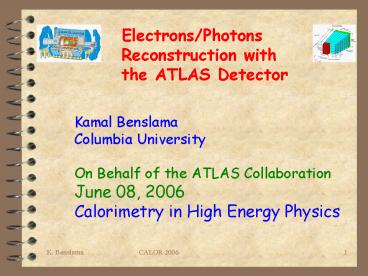Les Higgs au LHC PowerPoint PPT Presentation
1 / 28
Title: Les Higgs au LHC
1
Electrons/Photons Reconstruction with the ATLAS
Detector
Kamal Benslama Columbia University On Behalf of
the ATLAS Collaboration June 08, 2006 Calorimetry
in High Energy Physics
2
Physics Motivations
- Higgs search
- BSM
- - TeV resonances
- - SUSY
- Many SM processes, top, Z to ee, W to en
- - Backgrounds to new physics
- - Calibration processes
3
ATLAS LAr EM Calorimeter
4
Reconstruction Data Flow
5
Clustering and Corrections
- Sliding window clustering
- - build an eta-phi grid of towers and search
for local - maxima
- Corrections at the cluster level
- - eta position
- - phi position
- - phi energy modulation
- - eta energy modulation
- - gap correction
- - layer weights correction
- these corrections are derived using single
electrons - Refinement of corrections depending on the
particle (e/g) - type
- Inter-calibrate region with Zee
6
Cluster Correction eta position
- Clustering with fixed size
- - Correct position S-shape in eta
- - Essentially to account for fine
granularities of LAr Calorimeter
before correction
after correction
0.002
Small energy and particle dependence Currently
same correction for e and g
100 GeV electrons
7
Cluster Correction Eta Modulation
- Eta modulation of energy response
- Fixed calorimeter size with steps of 0.025,
therefore shower - containment is a function of eta
- Quadratic polynomial sufficient to correct for
effect of - about 0.1-0.2
8
Cluster Correction Phi Modulation
- Containment effect the same as for eta
- Additional component parameterized as sin/cos
sums - 0.1-0.2 effect
before correction
200 GeV electrons
Corrections are function of eta
after correction
Residual effect lt 0.03 after correction
9
Cluster Correction Layer Weights
- Layer Weights Correction
- - ATLAS Layer Weights (essentially only eta
dependent) - calculated using single electrons and
following parameterization
100 GeV e-
100 GeV e-
(E-Ebeam)/Ebeam
s((E-Ebeam)/Ebeam)
h
h
Optimize simultaneously energy resolution and
linearity
10
High pT Algorithm
- e-gamma reconstruction uses both calorimeter and
track - particle information as inputs. Properties of
the shower - are then computed
- For example
- - Leakage in Had. Cal ET(had-layer1)/ET(3
X7) - - Shower shape E2(3X7)/E2(7X7)
- - Energy weighted width in sampling 2
- - Energy fraction, energy weighted shower
width - in the first sampling
- The track match is searched for with the
following criteria - E/P cut and matching in eta and phi
(extrapolated to calo)
11
Low pT Algorithm
- For each track
- - apply track quality cuts
- - extrapolate to particular sampling of EM
Calo - In each sampling look for the cell with max E
deposit - Create cluster around that cell
- Estimate discriminating variables
12
Identification Description
13
eID/jet Rejection
Dijet cross section 1mb Z to ee 1.5x10-6 mb W
to en 1.5x10-5 mb Need a rejection factor of 105
for electrons
Identification methods Cuts Neural
net likelihood
Cuts are binned so far in eta (pT coming)
14
eID/jet Rejection
- Use the shower shapes in the calorimeter
- hadronic leakage
- width in the second sampling
- ratio in the middle of 3x7/7x7
- width in 40 strips
- Search for secondary maxima in
- the strips
- ?EEmax2-Emin
- ShowerCore
- Fside (E7strips-E3strips)/E3strips
wtot1
Lateral width wh2
E237/E277
DE
15
eID/jet Rejection Results
e-id efficiency
rejection
For a 75-80 e-id efficiency, a rejection 105 is
achieved
Rejection can be improved using multivariate
techniques
16
g/jet Separation
- Data Used
- - single g or g from H to gg
- - QCD dijets with pT gt 17 GeV (low lumi)
- and 25 GeV (high lumi)
- For e 80 R 7000
- Rejection of quark jets
- 3000
- Rejection of gluon jets
- 21000
17
Low pT Electron Identification
18
Low pT eID Results
PDF and neural net for ID analysis dependant
Rejection
J/Psi
WH
ttH
Eff
19
Conclusion
- Electrons and photons ID are essential
ingredients - for new physics at the LHC
- Procedures and methods for calibration are
- established and tested in test beam
- Different algorithms for eID/gID have been
- developed
- Dedicated algorithms needed for e- from bs
have - been developed
20
Backup Slides
21
Phi Position Correction
22
Gap Correction
23
Gap Correction
24
Layer Weights
0.28
50 GeV
0.15
100 GeV
25
Uniformity and Z?ee
- uniformity 0.2x0.4 ok in testbeam
- 1 quasi online
- 0.5 difficult
- energy scale stable to 0.13
- description of testbeam data by Monte Carlo
satisfactory - make use of Z?ee Monte Carlo and Data in ATLAS
for intercalibration of regions - 448 regions in ATLAS (denoted by i)
- mass of Z know precisely
- Eireco Eitrue(1ai)
- Mijreco Mijtrue(1(aiaj)/2)
- fit to reference distribution
At low (but nominal) luminosity, 0.3 of
intercalibration can be achieved in a week (plus
E/P later on)! Global constant term of 0.7
achievable! Testbeam 0.62 and 0.56 global
constant term already achieved Module to module
variation 0.05
26
?/p0 Separation
- use finely segmented first CALO compartment and
search for secondary maxima, - shower width etc
- need a separation factor of at least 3
E2nd max - Emin
27
g Conversions and its Effects on g/p0
28
e/jet Separation Results

